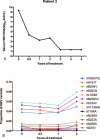Dynamics of Genotypic Mutations of the Hepatitis B Virus Associated With Long-Term Entecavir Treatment Determined With Ultradeep Pyrosequencing: A Retrospective Observational Study
- PMID: 26825915
- PMCID: PMC5291585
- DOI: 10.1097/MD.0000000000002614
Dynamics of Genotypic Mutations of the Hepatitis B Virus Associated With Long-Term Entecavir Treatment Determined With Ultradeep Pyrosequencing: A Retrospective Observational Study
Abstract
The aim of the study is to explore the evolution of genotypic mutations within the reverse transcriptase region in partial virological responders (PVRs) receiving long-term entecavir (ETV) treatment. A total of 32 patients were classified as completely virological responders (CVRs) (n = 12) or PVRs (n = 20). Five partial responders were hepatitis B virus (HBV)-DNA positive after long-term therapy, which lasted for >3 years. A total of 71 serum samples from these 32 patients were assayed by ultra-deep pyrosequencing (UDPS): 32 samples were from all patients at baseline, and 39 were from PVRs with sequential inter-treatment. Approximately 84,708 sequences were generated per sample. At baseline, the quasispecies heterogeneity did not significantly differ between the 2 groups. The frequencies of substitutions indicating pre-existence of nucleos(t)ide analog resistant (NAr) mutants ranged from 0.10% to 6.70%, which did not statistically differ between groups either. However, the substitutions associated with the NAr mutants were significantly different from those associated with the non-NAr mutants in 13 patients; 6 of these patients were PVRs and the others were CVRs. Five patients were HBV DNA positive after regular ETV monotherapy for >3 years, and 4 of these patients underwent mild NAr substitution fluctuations (<20%). One patient developed virological breakthrough while bearing single, double, and triple (rtL180 M, rtM204 V, rtS202G) substitutions. In addition to the common substitutions, unknown amino acid substitutions, such as rtL145 M/S, rtF151Y/L, rtR153Q, rtI224 V, rtN248H, rtS223A, rtS256C, need to be further verified. NAr substitutions are observed at frequencies of 0.10% to 6.7% before therapy. Long-term ETV therapy generally results in virological responses, as long as the proportion of resistance mutations remains at a relatively low level. Genotypic resistance to ETV is detected in all PVRs receiving long-term ETV therapy.
Conflict of interest statement
The authors have no conflicts of interest to disclose.
Figures





Similar articles
-
Pre-existing mutations related to tenofovir in chronic hepatitis B patients with long-term nucleos(t)ide analogue drugs treatment by ultra-deep pyrosequencing.Oncotarget. 2016 Oct 25;7(43):70264-70275. doi: 10.18632/oncotarget.11840. Oncotarget. 2016. PMID: 27602500 Free PMC article.
-
Emergence of entecavir-resistant mutations in nucleos(t)ide-naive Japanese patients infected with hepatitis B virus: virological breakthrough is also dependent on adherence to medication.Scand J Gastroenterol. 2011 Sep;46(9):1111-7. doi: 10.3109/00365521.2011.584898. Epub 2011 May 30. Scand J Gastroenterol. 2011. PMID: 21623676
-
Long-term virological outcome in chronic hepatitis B patients with a partial virological response to entecavir.Korean J Intern Med. 2015 Mar;30(2):170-6. doi: 10.3904/kjim.2015.30.2.170. Epub 2015 Feb 27. Korean J Intern Med. 2015. PMID: 25750558 Free PMC article.
-
Evolutionary patterns of hepatitis B virus quasispecies under different selective pressures: correlation with antiviral efficacy.Gut. 2011 Sep;60(9):1269-77. doi: 10.1136/gut.2010.226225. Epub 2011 Feb 2. Gut. 2011. PMID: 21292683
-
Dynamics of hepatitis B virus resistance substitutions correlates with virological response in lamivudine-refractory patients with entecavir rescue monotherapy.Virus Res. 2013 Nov 6;177(2):156-62. doi: 10.1016/j.virusres.2013.08.003. Epub 2013 Aug 19. Virus Res. 2013. PMID: 23968804 Clinical Trial.
Cited by
-
Genomic Variability of Hepatitis B Virus Circulating in Brazilian Western Amazon.Viruses. 2022 Sep 22;14(10):2100. doi: 10.3390/v14102100. Viruses. 2022. PMID: 36298655 Free PMC article.
-
Quasispecies variant of pre-S/S gene in HBV-related hepatocellular carcinoma with HBs antigen positive and occult infection.Infect Agent Cancer. 2018 Feb 2;13:7. doi: 10.1186/s13027-018-0179-4. eCollection 2018. Infect Agent Cancer. 2018. PMID: 29434654 Free PMC article.
-
Pre-existing mutations related to tenofovir in chronic hepatitis B patients with long-term nucleos(t)ide analogue drugs treatment by ultra-deep pyrosequencing.Oncotarget. 2016 Oct 25;7(43):70264-70275. doi: 10.18632/oncotarget.11840. Oncotarget. 2016. PMID: 27602500 Free PMC article.
References
-
- Ott JJ, Stevens GA, Groeger J, et al. Global epidemiology of hepatitis B virus infection: new estimates of age-specific HBsAg seroprevalence and endemicity. Vaccine 2012; 30:2212–2219. - PubMed
-
- Bosch FX, Ribes J, Cleries R, et al. Epidemiology of hepatocellular carcinoma. Clinics Liver Disease 2005; 9:191–211. - PubMed
-
- McMahon BJ. The natural history of chronic hepatitis B virus infection. Hepatology 2009; 49 5 Suppl:S45–55. - PubMed
-
- Dienstag JL. Benefits and risks of nucleoside analog therapy for hepatitis B. Hepatology 2009; 49 5 Suppl:S112–121. - PubMed
Publication types
MeSH terms
Substances
LinkOut - more resources
Full Text Sources
Other Literature Sources

